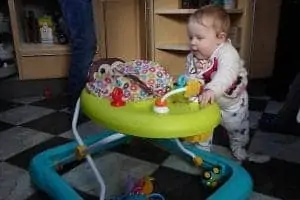If you spent any time researching baby walkers, you know there is some controversy in the parenting world about whether or not you should use a baby walker. If you want one, you must choose when to put your baby in the walker, which is another controversy.
The fact is, not even doctors agree about walker use, which makes it hard for parents to decide. Most toddlers walk by the time they’re 12 months old, but many parents use walkers to encourage skill development.
Whether or not you decide one is right for your child is up to you. However, you want to ensure you don’t use a walker too early; finding the right age for introduction is critical.
When Should I Introduce a Baby Walker?
When you’re thinking about when a baby can start using a walker, it depends on your child and their development.
Typically, doctors that recommend or don’t discourage their use suggest that parents try walkers around eight months old. By this age, most babies can sit upright and have more physical control over their bodies.
However, this is different for each baby. I’ve had a baby who walked at eight months old, and I also had a baby who didn’t want to sit independently at this age. That’s why it’s hard to pick one set of age to introduce a baby walker.
If your baby can accomplish or try to do several of these things, it might be time to buy a walker.
- Crawling
- Sits unsupported
- Tries to stand up on his own
- Curious about the world around him
- At least six months or older
The Pros and Cons of Using a Baby Walker
It would be unfair to say there aren’t any reasons to use walkers, even though some parents and doctors think this year. I haven’t always used baby walkers, but with the kids that I did, they did enjoy using them.
Here are some reasons you might want to try a baby walker.
- Your baby’s legs get a bit of a workout.
- It encourages your child to be more curious and explore the world around him. Of course, parents must be responsible and remove potential dangers.
- As your child learns to move his legs, it helps to develop coordination skills.
- Chances are your child will be happy and excited!
- Most walkers include rattles, rings, and other types, so your child stays stimulated and entertained.
Now, let’s look at why people think walkers aren’t such a good idea.
- It encourages the wrong type of walking. Your child walks without straining, mainly toe walking, and just pushing rather than holding their weight and coordinating steps.
- If your child uses a walker too long or too early, it could learn spinal curvature. This is why children must be physically ready for a walker.
- It could discourage your child from crawling since your child won’t spend as much time on all fours.
- There is an increased risk of trauma, such as concussions, bruises, and more.
- While your baby might be more curious, walkers also decrease your baby’s natural sense of fear.
Are Baby Walkers Safe to Use?
Despite the large number of parents who use walkers, we know they are unsafe for babies. Walkers are a leading cause of injury in children. The American Academy of Pediatrics highly discourages parents from the use of walkers.
Why are they considered unsafe? Here are a few serious points for parents to remember.
A Serious Risk of Falling From Stairs
Thousands of babies were injured from falling down the stairs in walkers. If you have stairs in your home, please think again about introducing one to your baby. It’s easy for a door to be left open that leads to your basement.
Loss of Balance
Babies can move fast in walkers, but since your child is not used to walking, he could lose his balance. 🙁
Head Injuries
Unfortunately, if your baby loses his balance, chances are he will hit his head. He can even hit his head without falling; furniture is at the perfect height to lead to bruises. Around 82% of reported injuries from walkers included a head injury.
Increase in Accidental Deaths
A mobile child that is sitting up in a walker gives them access to things that can be harmful. Your child might reach hot food, stoves, poisonous substances, or other dangerous or deadly items.
How to Use a Baby Walker Safely
You must follow the recommended safety precautions with your child!
- Only use walkers on flat, even surfaces.
- Never use a walker near a staircase or bodies of water, including a pool.
- An adult must be present and watch the baby the entire time the baby uses it.
- Keep unsafe, sharp, or pointed objects away from your baby. Heavy or breakable objects should be moved elsewhere, preferably to another room.

How Long Should My Baby Use a Walker
If you wait until your child stops showing interest in a walker, you will increase the risk of problems developing. Your baby might want to spend hours in his walker, but that’s not smart. We know that extended use can lead to spinal problems or curvature.
Here are some suggestions.
- Build up how long you leave your child in it. Try 5-10 minutes at a time for several days.
- Your baby will need time to master the walker, so expect a learning curve. Be patient with your child.
- Use it for no more than 40 minutes per day in total.
What to Look for When Buying a Baby Walker
If you decide that you do want to buy one, you have to pick the right option. The most important criteria are safety – you don’t want your child to be in danger or unsafe. So, let’s look at what are the essential features.
A Solid, Wide Base
When you’re picking a walker, make sure that the base is wider than the top. This adds more stability and decreases the risk of tipping over.
Properly Sized Wheels
Since your baby needs the wheels to zip all over the place, they play a significant factor when picking a walker. Big wheels are safer; rubber, floating wheels make it easier for your baby to maneuver around your house. There should be at least 16 wheels – 8 pairs total.
Bumper and Stopper
It’s not a question of IF your child will hit something; it’s only a matter of when. My child ran into tables, couches, and more. An anti-bump system helps reduce the shock when he runs into furniture, keeping your baby.
Height Regulator
Your baby shouldn’t climb out of the walker, so a height regulator helps to adjust it as your baby grows. If you don’t see something that lets you adjust the height, don’t buy that model!
The Seat
I highly recommend that you look for a water-resistant, machine-washable seat. Babies are messy, and you will deal with a few diaper explosions. If you can’t toss the seat material into the washer, you’ll waste time spot cleaning.
Extra Features
Last, look at what extra features are included! You want a walker with musical toys, lights, and other exciting toys to entertain your child. These objects may seem useless, but they help to encourage the development of your baby’s senses.
Alternatives to Baby Walkers
There are alternatives! Playpens, play yards, or stationary activity centers are all safe options that encourage physical development. Babies love activity centers, and they have no wheels.
Final Thoughts
Only parents can decide when is the right age to use a baby walker. Ensure your baby shows some of the signs that he is physically ready for one before introducing it. You want to avoid spinal problems and use safety tips to keep your child safe while having fun.
Hey, this is Linda. My biggest accomplishment in life is being a mother of four children. Their current ages range from almost ten years old down to 20 months old.
I’m passionate about writing parenting articles because I understand so well all of the problems and trials you face as a parent. From breastfeeding woes to budgeting problems and behavior problems, along with everything in between, chances are I’ve faced it over the last ten years. Read more about Linda here.





